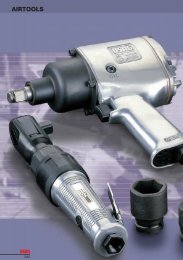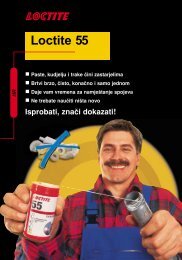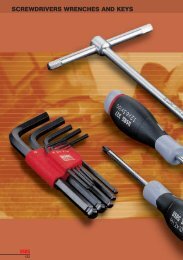Industrial seal self study guide - SKF.com
Industrial seal self study guide - SKF.com
Industrial seal self study guide - SKF.com
You also want an ePaper? Increase the reach of your titles
YUMPU automatically turns print PDFs into web optimized ePapers that Google loves.
SEAL DESIGN GROUPS (cont.)<br />
Hydrodynamic Seals<br />
One of the most significant developments in <strong>seal</strong>ing technology<br />
occurred in the 1950’s with the introduction of hydrodynamic <strong>seal</strong>s.<br />
Hydrodynamic <strong>seal</strong>s have molded projections added to the <strong>seal</strong> lip<br />
which enables the <strong>seal</strong> to pump oil into the oil pump, improving<br />
lubricant retention.<br />
Standard hydrodynamic <strong>seal</strong> designs<br />
feature helical ribs, parabolic ribs or<br />
triangular pads (fig. 3e).<br />
There are a variety of molded projections used in hydrodynamic<br />
<strong>seal</strong>s. Standard designs have a series of helical ribs, parabolic<br />
triangular pads molded to the lip (fig. 3e). However, these designs<br />
are not without their problems. As dirt builds up against the <strong>seal</strong> lip,<br />
the lip wears, eliminating the hydrodynamic projections. They can also<br />
be<strong>com</strong>e clogged with carbon or dirt. Some hydrodynamic designs are<br />
uni-directional, and can actually pump lubricant out if installed incorrectly.<br />
<strong>SKF</strong> developed a new type of hydrodynamic <strong>seal</strong> in the early 1970’s.<br />
Called “Wave<strong>seal</strong>”, this design features a <strong>seal</strong>ing lip molded with a<br />
sinewave pattern. This traces a wavy path over the surface of the<br />
rotating shaft.<br />
Low Angle<br />
Steep Angle<br />
Scraper<br />
Wave<strong>seal</strong><br />
In technical terms, the <strong>SKF</strong> Wave<strong>seal</strong> is a smooth lip,<br />
bi-rotational hydrodynamic, molded radial lip <strong>seal</strong>. More simply, it is a<br />
shaft <strong>seal</strong> that pumps lubricant back into the sump while <strong>seal</strong>ing out<br />
contaminants no matter which way the shaft is turning.<br />
Low Angle<br />
Permits Oil<br />
To Slide<br />
Under Lip<br />
Steep Angle<br />
Scrapes Oil<br />
Inward<br />
Shaft<br />
Rotation<br />
The Wave<strong>seal</strong> by <strong>SKF</strong><br />
• Offers longer, more dependable performance and service life than<br />
conventional trimmed lip <strong>seal</strong>s and other hydrodynamic designs.<br />
• Has almost universal applications<br />
• Is the first standard line of shaft <strong>seal</strong>s incorporating hydrodynamics<br />
Static<br />
Contact<br />
Path<br />
Air Side<br />
Oil Particles<br />
Dynamic<br />
Contact<br />
Path<br />
Oil Side<br />
The <strong>SKF</strong> Wave<strong>seal</strong> touches the shaft<br />
in wide ‘sine’ or wave pattern. Due to<br />
this unique design, contact pressure<br />
and grooving are minimized, heat<br />
generation and friction are reduced.<br />
Lubricant is pumped back to the<br />
bearing while dirt is pushed away<br />
from the lip/shaft interface (fig. 3f).<br />
How Wave<strong>seal</strong>s Work<br />
The Wave<strong>seal</strong> by <strong>SKF</strong> makes a sweeping contact with the shaft. Its<br />
unique, specially molded lip rides the shaft forming a sinusoidal or<br />
wave pattern around the shaft surface (fig. 3f).<br />
This unique pattern generates less heat, reduces shaft wear and<br />
provides greater lip lubrication than standard lip designs. Its pumping<br />
power is maintained at the same level throughout its service life.<br />
14







